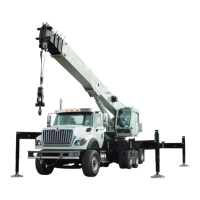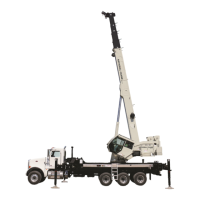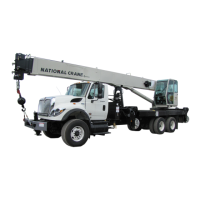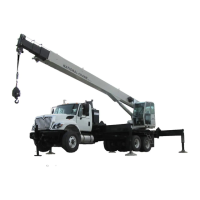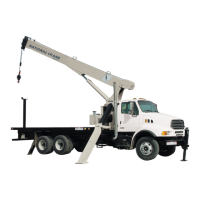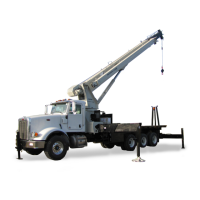NATIONAL CRANE Published 11-01-2020 Control # 710-00 2-21
NBT60XL OPERATOR MANUAL SAFETY PRECAUTIONS
In addition to the operating requirements that are detailed in
the operating manuals and on the load capacity chart, pile
driving and extracting operations are approved by National
Crane, provided all guidelines outlined below are followed:
• All pile driving and extracting operations shall be
restricted to fully extended outriggers with all tires clear
of the ground.
• The combined weight of the driver or extractor, piling,
leads, attachments, etc., shall not exceed 80% of the
published load chart values for on-outriggers operation.
• The pile driver or pile extractor and attachments shall be
kept clear of the boom nose at all times.
• The pile driver and piling shall be suspended from a
hoist cable with sufficient line speed to meet or exceed
the rate of descent of the driver and piling to preclude
impact loading or vibration from being induced into the
boom and equipment structure.
• Pile driving or extracting shall be restricted to over the
main boom only and shall not be permitted over a jib.
• Pile extraction using only the equipment hoist line is
unsafe and not permitted since load values cannot be
accurately determined. Only pile extraction devices that
do not transmit vibration or shock loading into the
equipment are permitted. All possible precautionary
measures shall be taken to prevent shock loads or
vibration from being imposed on equipment
components, either directly through the hoist cable or
indirectly from ground borne vibration.
• The load lines shall be kept vertical at all times during
pile driving and pile extraction operations.
• The operator and other personnel associated with the
pile driving and pile extraction operation shall have read
and understood all safety standards applicable to
equipment operations as well as being thoroughly
trained in the safe operation of pile driving and extracting
equipment.
Equipment
• Hoists shall be equipped with a cable follower to aid in
proper spooling of cable.
• All cable retainer pins and cable guides/retainers shall
be in place.
• All jibs must be removed from the machine before pile
driving or extraction begins.
• All hoist hooks shall be equipped with a positive locking
latch.
Equipment Inspection
• In addition to the equipment's frequent and periodic
inspections, dated daily records shall be maintained
showing inspections were performed on the equipment
during the time it was used for pile driving or extraction.
• All anti-two-block warning devices and RCL systems
shall be inspected daily and verified to be functional.
• All areas of the equipment subject to fatigue shall be
inspected monthly, and before the equipment is to return
to lifting service.
• The boom shall be inspected daily to make sure that all
wear pads remain in place. Equipment which utilize
pinned boom sections shall be inspected daily to make
sure that the pinning mechanism operates properly and
to check for undue wear at the pins and pinning plates.
• The hoist cable shall be inspected daily to make sure
that no chafing or wear is occurring.
ELECTROCUTION HAZARD
Thoroughly read, understand, and abide by all applicable
federal, state, and local regulations regarding operation of
equipment near electric power lines or equipment.
United States federal law prohibits the use of
equipment closer than 6 m (20 ft) to power
sources up to 350 kV and greater distances for
higher voltages unless the line’s voltage is
known [29CFR1910.180 and 29CFR1926, sub-
part CC].
To avoid death or serious injury, National Crane
recommends that all parts of the equipment,
boom, and load be kept at least 6 m (20 ft) away
from all electrical power lines and equipment
less than 350 kV.
NOTE: For detailed guidelines on operating near power
lines, refer to the current edition of OSHA
29CFR1926.1408 and ASME B30.5 American
National Standard.
If operation within 3 m (10 ft) of any power lines cannot be
avoided, the power utility must be notified and the power
lines must be de-energized and grounded before
performing any work.
Electrocution can occur even without direct contact with
the equipment.
DANGER
Electrocution Hazard!
National Crane equipments are not equipped with all
features required to operate within OSHA
29CFR1926.1408, Table A clearances when the power
lines are energized.
Fo
r
Reference
Only
